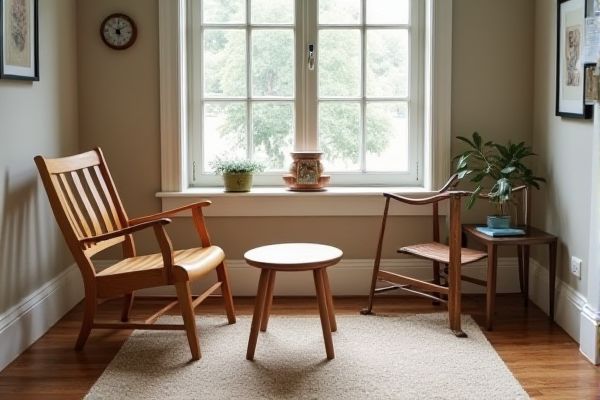
Shaker chairs feature clean lines and minimalist design emphasizing functionality, while ladderback chairs are characterized by their horizontal slats and traditional craftsmanship, offering rustic charm and sturdy support. Discover how to choose the perfect style for your home in the rest of this article.
Table of Comparison
| Feature | Shaker Chair | Ladderback Chair |
|---|---|---|
| Origin | 18th-century American Shaker communities | 16th-century English rustic furniture tradition |
| Design | Simple, minimalist, functional with straight lines | Horizontal wooden slats forming the backrest resembling a ladder |
| Materials | Mostly hardwoods like maple or cherry | Commonly oak or other hardwoods |
| Backrest | Often solid or with minimal spindles | Multiple horizontal slats (usually 3-5) |
| Seat | Shaker tape or wood | Woven rush, cane, or wood |
| Purpose | Functional, designed for simplicity and durability | Rustic home use, offering comfort and durability |
| Visual Style | Minimal ornamentation, clean lines | Traditional, rustic, sometimes decorative carvings |
| Popularity | Favored in minimalist and modern farmhouse designs | Popular in country and rustic interior styles |
Introduction to Shaker and Ladderback Chairs
Shaker chairs feature minimalist design and clean lines, emphasizing functionality and craftsmanship rooted in 18th-century American Quaker communities. Ladderback chairs showcase horizontal slats resembling ladders on the backrest, offering sturdy support and a rustic aesthetic linked to traditional English and Colonial American furniture. Your choice depends on whether you prefer the Shaker's simplicity and elegance or the Ladderback's classic, robust design.
Historical Origins and Evolution
Shaker chairs originated in the 18th century, crafted by the Shaker religious community in America, emphasizing simplicity, functionality, and minimal ornamentation. Ladderback chairs trace their roots to 17th-century Europe, characterized by horizontal slats resembling a ladder on the backrest, evolving from rustic farmhouse furniture to elegant designs. Both styles reflect cultural values and craftsmanship but diverge in design philosophy and historical evolution.
Key Design Features Compared
Shaker chairs feature clean lines, flat seats, and simple, spindle-back designs emphasizing functionality and minimalism. Ladderback chairs are characterized by horizontal slats running across the backrest, often with woven rush seats, providing both comfort and rustic charm. Choosing between these styles depends on Your preference for either the Shaker's sleek geometry or the Ladderback's traditional, textured look.
Material Selection and Craftsmanship
Shaker chairs are known for their minimalist design, typically crafted from hardwoods such as maple, cherry, or pine, emphasizing durability and simplicity through precise joinery and hand-crafted details. Ladderback chairs often use oak or ash, highlighting a rustic aesthetic with turned or woven elements that showcase traditional woodworking skills. Your choice between these styles depends on whether you prefer the clean lines and refined craftsmanship of Shaker chairs or the robust, textured construction of ladderback chairs.
Comfort and Ergonomics
Shaker chairs prioritize simplicity and functionality with a straight back and flat seat, offering moderate comfort but less ergonomic support for prolonged sitting. Ladderback chairs feature horizontal slats on the backrest, providing better lumbar support and improved airflow, contributing to enhanced comfort during extended use. Ergonomically, ladderback chairs often conform more naturally to the spine's curvature, reducing strain compared to the rigid design of typical Shaker chairs.
Durability and Longevity
Shaker chairs, crafted from strong hardwoods like maple or cherry, are renowned for their exceptional durability and ability to withstand daily wear over decades. Ladderback chairs, often made from a variety of woods including oak or hickory, also offer solid construction but may show signs of wear faster due to their slatted back design. Your choice between these styles can impact long-term maintenance, with Shaker chairs generally providing greater longevity and structural stability.
Style and Aesthetic Appeal
Shaker chairs exhibit minimalist design with clean lines and functional form, emphasizing simplicity and craftsmanship, while ladderback chairs feature horizontal slats on the backrest, offering a rustic and traditional aesthetic. The Shaker style aligns with modern and Scandinavian interiors due to its understated elegance, whereas ladderback chairs complement farmhouse and country-style decor with their sturdy, handcrafted appearance. Both styles highlight wood grain textures, but Shaker chairs prioritize symmetry and smooth finishes compared to the more exposed, rugged look of ladderback chairs.
Versatility in Home Decor
Shaker chairs offer timeless simplicity and clean lines that seamlessly complement minimalist, rustic, and modern farmhouse styles, enhancing versatility in home decor. Ladderback chairs, characterized by their slatted back design, bring a classic and cozy farmhouse charm that blends well with traditional and country-inspired interiors. Both chair styles provide adaptable seating options, allowing homeowners to mix and match with various decor elements for a cohesive aesthetic.
Price Comparison and Value
Shaker chairs typically offer a more affordable price point due to their minimalist design and durable construction, making them a cost-effective choice for budget-conscious buyers. Ladderback chairs, often crafted with decorative elements and varied wood finishes, may carry a higher price but provide added aesthetic value and traditional charm. Your decision should balance the initial cost with the long-term value, considering durability, style preference, and how the chair complements your existing decor.
Which Chair Should You Choose?
Choose a Shaker chair for minimalist design, durability, and clean lines that complement modern or rustic interiors. Opt for a Ladderback chair if you prefer a traditional aesthetic with vertical slats providing strong back support and a timeless farmhouse appeal. Consider factors like comfort preference, interior style, and handcrafted quality when deciding between Shaker and Ladderback chairs.
 homyna.com
homyna.com